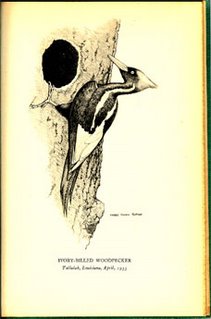 I know someone who knew someone who sketched this Ivory-bill woodpecker from life. My friend Bill Dilger, retired Cornell biologist, recently shared his copy of George Sutton's book, Birds in the Wilderness, with me. The book is inscribed: "To my friend Bill Dilger in celebration of his twenty-third, the most important, birthday of his life." It was 1946. After years in the Army in Burma and India, Bill was back in school at Cornell. To help pay his way through school, Bill worked with Sutton in the vertebrate collection. A large collection of mostly unlabeled bird skins had been donated by a hobbyist and they were fully occupied identifying and labeling them. Over the years of their friendship, Bill learned a great deal about drawing and painting.
I know someone who knew someone who sketched this Ivory-bill woodpecker from life. My friend Bill Dilger, retired Cornell biologist, recently shared his copy of George Sutton's book, Birds in the Wilderness, with me. The book is inscribed: "To my friend Bill Dilger in celebration of his twenty-third, the most important, birthday of his life." It was 1946. After years in the Army in Burma and India, Bill was back in school at Cornell. To help pay his way through school, Bill worked with Sutton in the vertebrate collection. A large collection of mostly unlabeled bird skins had been donated by a hobbyist and they were fully occupied identifying and labeling them. Over the years of their friendship, Bill learned a great deal about drawing and painting.One chapter of Birds in the Wilderness is devoted to Kints -- Ivory-bill woodpeckers. In the Tinsaw valley of Louisiana, in 1935, Sutton and Dr. Arthur Allen were introduced to a local attorney, Mr. Spencer, who offered to put them in touch with friends who would help them find the Ivory-bills. Sutton writes:
"We were amazed to learn that mammalogists consider wolves more common in this section of Louisiana than in any other part of the United States. Wild Turkeys were abundant. White-tailed deer thronged the swamplands. I was still in some doubt, however, about the Ivory-bills. Fearing that Mr. Spencer might, in his eagerness to help us, be confusing the Ivory-bill with the Pileated, which is also a large and showy woodpecker, I said, "Mr. Spencer, you're sure the bird
you're telling us about isn't the big Pileated Woodpecker, the bird the Florida Crackers call the 'Lord God Almighty'?"
"Man alive!" answered Mr. Spencer hotly, "These birds I'm tellin' you all about is Kints! Why, the Pileated Woodpecker's just a little bird about as big as that" -- he indicated with his fingers an object a few inches long -- "and a Kint's as big as that!" He moved his arms generously apart, fisherman fashion, and glared at me. "Why, man, I've known Kints all my life. My pappy showed 'em to me when I was just a kid. I see 'em every fall when I go deer huntin' down aroun' my place on the Tinsaw. They're big birds, I tell you, big and black and white; and they fly through the woods like Pintail Ducks!"
This colorful discourse left no doubt in our minds that Mr. Spencer's 'Kints' were genuine Ivory-bills.
After three days of wading through the swamps Sutton and his companions found a pair of Ivory-bills and their nest!
"The whole experience was like a dream. There we sat in the wild swamp, miles and miles from any highway, with two Ivory-billed Woodpeckers so close to us that we could see their eyes, their long toes, even their strongly curved claws with our binoculars. The male bird sighted me, called more rapidly, and then, instead of flying off in alarm, swung to a tree above me, looked at me first with one eye then with the other, and stationed himself not more than than thirty feet away. What a splendid creature he was! He called loudly, preened himself, shook out his plumage, rapped defiantly, then hitched down the trunk to look at me more closely. As I beheld his scarlet crest and white shoulder straps I felt that I had never seen a more strikingly handsome bird. His crest was gorgeous. But somehow what struck me most was the rich whiteness of his beak and the staring whiteness of his eye."
Sutton returned the next day and sketched for hours. "The mosquitoes were not bothersome." Dr. Allen took photographs and plotted how to get their unwieldy sound-recording equipment to this remote location.
"We had found our Ivory-bills and made drawings of them. Mr. Spencer's 'Kints' were no longer a new and funny word; they were an experience, an achievement, a memory."
Cross posted at Whorled Leaves

No comments:
Post a Comment